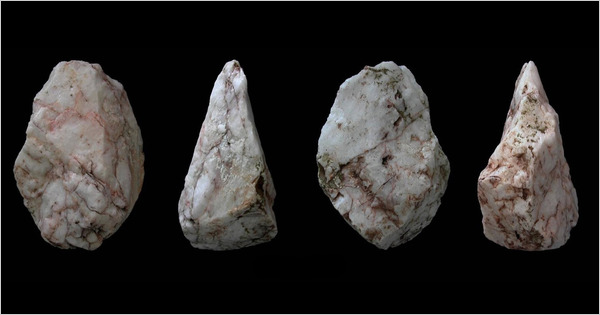
Ancient stone tools recently found on Crete has led archaeologists to push back the origins of seafaring by at least 70,000 years
An exciting archaeological discovery in Crete was just published in the New York Times with remarkable implications regarding the dawn of human seafaring:
Early humans, possibly even prehuman ancestors, appear to have been going to sea much longer than anyone had ever suspected.
That is the startling implication of discoveries made the last two summers on the Greek island of Crete. Stone tools found there, archaeologists say, are at least 130,000 years old, which is considered strong evidence for the earliest known seafaring in the Mediterranean and cause for rethinking the maritime capabilities of prehuman cultures.
Crete has been an island for the last five million years, which means the only way that these artifacts, and the humans who made them, could have gotten there was by boat. Before these finds, the earliest evidence of Mediterranean seafaring was the distribution of obsidian on a number of Aegean islands dating to around 10,000 to 12,000 years ago, and the earliest evidence of seafaring anywhere in the world was dated to 60,000 years ago with the peopling of Australia. The artifacts unearthed on Crete in 2008 and 2009 have been firmly dated to at least 130,000 years of age, and might possibly be considerably older:
Even more intriguing, the archaeologists who found the tools on Crete noted that the style of the hand axes suggested that they could be up to 700,000 years old. That may be a stretch, they conceded, but the tools resemble artifacts from the stone technology known as Acheulean, which originated with prehuman populations in Africa.
The team of Greek and American archaeologists and geologists discovered over 2,000 individual stone tools, including quartz hand axes, cleavers, and scrapers, from excavations near the town of Plakias on the southwest coast of Crete. The researchers had been expecting to locate typical tools of the Mesolithic and Neolithic (Middle and Late Stone Age) periods, dating to no later than perhaps 11,000 years. In addition to these expected artifacts, they came across stone hand axes and other much older material, dating to the Paleolithic (Early Stone Age) period.
“We were flummoxed,” Dr. Runnels said in an interview. “These things were just not supposed to be there.”
Word of the find is circulating among the ranks of Stone Age scholars. The few who have seen the data and some pictures — most of the tools reside in Athens — said they were excited and cautiously impressed. The research, if confirmed by further study, scrambles timetables of technological development and textbook accounts of human and prehuman mobility.
The 130,000-year date would put the discovery in a time when Homo sapiens had already evolved in Africa, sometime after 200,000 years ago. Their presence in Europe did not become apparent until about 50,000 years ago.
Archaeologists can only speculate about who the toolmakers were. One hundred and thirty thousand years ago, modern humans shared the world with other hominids, like Neanderthals and Homo heidelbergensis. The Acheulean culture is thought to have started with Homo erectus.
[A]rchaeologists and experts on early nautical history said the discovery appeared to show that these surprisingly ancient mariners had craft sturdier and more reliable than rafts. They also must have had the cognitive ability to conceive and carry out repeated water crossing over great distances in order to establish sustainable populations producing an abundance of stone artifacts.
If the analysis currently underway confirms these preliminary dates, this could be one of the most significant archaeological discoveries ever made, and will re-write our understanding of ancient maritime prehistory. And we thought our port of St. Augustine was old!

